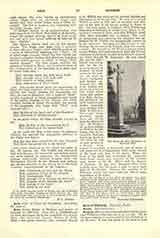

Acca, Saint, Bishop of Hexham, and patron of learning (c. 660-742). Acca was a Northumbrian by birth and began life in the household of a certain Rosa, who afterwards became Bishop of York. After a few years, however, Acca attached himself to St. Wilfrid and remained his devoted disciple and companion in all his troubles. He may have joined Wilfrid as early as 678, and he certainly was with him at the time of his second journey to Rome in 692. On their return to England, when Wilfrid was reinstated at Hexham, be made Acca Abbot of St. Andrew’s monastery there; and after Wilfrid’s death (709) Acca succeeded him as bishop. The work of completing and adorning the churches left unfinished by St. Wilfrid was energetically carried on by his successor. In ruling the diocese and in conducting the services of the Church, Acca was equally zealous. He brought to the North a famous cantor named Maban, who had learned in Kent the Roman traditions of psalmody handed down from St. Gregory the Great through St. Augustine. He was famed also for his theological learning, and for his encouragement of students by every means in his power. It was at Acca’s instigation that Eddius undertook the Life of St. Wilfrid, and above all, it was to the same kind friend and patron that Bede dedicated several of his most important works, especially those dealing with Holy Scripture.
For some unexplained reason Acca was driven from his diocese in 732. He is believed to have retired to Withern in Galloway, but he returned to Hexham before his death in 742 when he was at once revered as a Saint. Two crosses of exquisite workmanship, one of which is still preserved in a fragmentary state, were erected at the head and foot of his grave. When the body of the Saint was translated, the vestments were found entire, and accounts of his miracles were drawn up by St. Aelred and by Simeon of Durham. Of any true liturgical cultus there is little trace, but his feast is said to have been kept on October 20. There is also mention of February 19, which may have been the date of some translation of his relics.
HERBERT THURSTON

